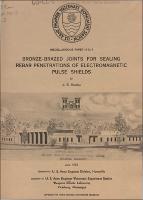Please use this identifier to cite or link to this item:
https://hdl.handle.net/11681/6789Full metadata record
| DC Field | Value | Language |
|---|---|---|
| dc.contributor | United States. Army. Corps of Engineers. Huntsville Division | - |
| dc.contributor.author | Hossley, J. R. (James R.) | - |
| dc.date.accessioned | 2016-03-23T20:32:08Z | - |
| dc.date.available | 2016-03-23T20:32:08Z | - |
| dc.date.issued | 1972-06 | - |
| dc.identifier.uri | http://hdl.handle.net/11681/6789 | - |
| dc.description | Miscellaneous paper | - |
| dc.description | Abstract: The objective of this study was to determine whether bronze brazing could be used to seal steel reinforcing bar penetrations through the electromagnetic pulse (EMF) shields of Perimeter Acquisition Radar Buildings (FARB) when such seal joints are required to withstand design loads without degradation of the EMF shielding properties or of the mechanical properties of the reinforcing bars. Initially, five tests were performed on three concrete-encased bars that represented full-scale penetrations of reinforcing bars (No. 11, Grade 75) through 1/4-inch-thick steel plates that represented the EMF shield. After completion of each test, the concrete was removed from the brazed joint, and dye penetrant was used to examine the joint for cracking. During this initial series of five tests, it became evident that a significant degradation in bar ductility had occurred as a result of the brazing process. Consequently, 26 tension tests were performed on No. 11 bars with a 1/4-inch-thick steel plate attached by four different methods, i.e. bronze braze, preheated bronze braze, alloy braze, and Cadweld splice, to determine a bra7,ing technique that did not degrade bar ductility. All samples were tested at static or dynamic (intermediate) loading rates. The time to yield at the intermediate loading rate was about 0.10 second (approximately 0.08 in/in/sec). Transient load and strain measurements were recorded during the tests. The results of the full-scale penetration tests indicated that it is possible for a brazed penetration of the type tested to withstand shear and tensile loads of a magnitude expected in a PARE. The test results, however, indicated that the brazing process caused a significant reduction in the ductility of the reinforcing bar. All tension-tested samples exceeded the American Society for Testing and Material's minimum requirements for tensile and yield strength; however, the test results indicated that brazing of the Grade 75 reinforcing bars can result in a considerable loss of ductility (elongation at rupture being less than 1 percent) if during brazing the temperature is excessive. If the brazing procedure outlined in Appendix A is used by an experienced and certified welder, bar elongations greater than 5 percent can be obtained. The Cadweld-spliced samples produced the greatest final elongation (8.5 percent). Test results showed that the brazed joint between the bar and plate leaked dye penetrant at approximately 2.5 percent bar elongation. Thus, it is possible that the EMP shielding properties will be significantly degraded at bar elongations above 2.5 percent. | - |
| dc.publisher | Weapons Effects Laboratory (U.S.) | - |
| dc.publisher | Engineer Research and Development Center (U.S.) | - |
| dc.relation | http://acwc.sdp.sirsi.net/client/en_US/search/asset/1048386 | - |
| dc.relation.ispartofseries | Miscellaneous paper (U.S. Army Engineer Waterways Experiment Station) ; N-72-7. | - |
| dc.rights | Approved for public release; distribution is unlimited. | - |
| dc.source | This Digital Resource was created from scans of the Print Resource. | - |
| dc.subject | Bronze brazing | - |
| dc.subject | Electromagnetic pulse shields | - |
| dc.subject | Joints (Junctions) | - |
| dc.subject | Penetration | - |
| dc.subject | Reinforcing steels | - |
| dc.subject | Sealing | - |
| dc.subject | Steel bars | - |
| dc.title | Bronze-brazed joints for sealing rebar penetrations of electromagnetic pulse shields | - |
| dc.type | Report | en_US |
| Appears in Collections: | Miscellaneous Paper | |
Files in This Item:
| File | Description | Size | Format | |
|---|---|---|---|---|
| MP-N-72-7.pdf | 3.26 MB | Adobe PDF |  View/Open |